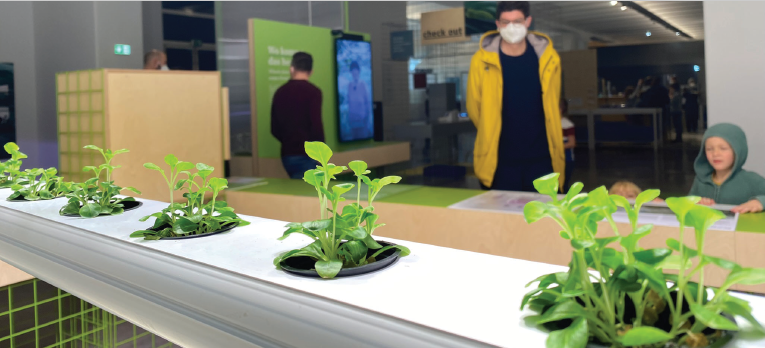vertical farm institute @FoodPrint Exhibition
ALINA – a prototype by our euPOLIS partner, the VFI, as an essential component of the FoodPrint Exhibition, initially showcased at the Technisches Museum Wien in 2002, followed by an exhibition in DASA Dortmund the subsequent year, remains on display at Parque de las Ciencias in Granada until September 4th (2024).

-ALINA aims to enable open discussions on how we used to produce, produce, and will produce food. The dissemination sculpture explains the connection between light, water, fertilizers, substrates, and photosynthesis. It is a dynamic sculpture where visitors are invited to watch the dynamics of the growth process of several plants throughout the exhibition period. It wants to sensitize for alternative food production methods and cultivation practices in constant evolution and transformation– states the Vertical Farm Institute team, about the ALINA – Static Vertical Farm Demonstrator whose dynamic design mirrors the motion of the paternoster system.
ALINA is an integral part of the FoodPrint Exhibition already displayed in Techisches Museum Wien in 2002, followed by the exhibition in DASA Dortmund the year after. Finally, you can still see it in Parque de las Ciencias in Granada until September 4th (2024).
TasteLAB
A special highlight of the exhibition was the interactive educational area “tasteLAB”, where the exhibition topics could be tasted with all senses. In addition, a diverse educational program awaited individuals and school classes from 1st-13th grade, which made the topics of sustainability, nutrition, and technology tastily tangible in workshops and guided tours.

-Too often it seems that efforts of parts of our society to draw attention to current challenges related to maintaining a habitable zone for us are leading nowhere. This may have to do with the level of complexity of our systems, which we are continuously developing. In systems theory terms, it is easy to answer the whole topic dystopically and declare that every system increases in complexity until it collapses. This is culturally and historically easy to prove. Nevertheless, there is a large percentage of people who already see or even invented, tested, or developed approaches to repair or correct parts, perhaps not of the system as a whole, but at least for one or more structural elements in it – Daniel Podmirseg of the VFI explains. To him, it is about popping the big question in everyone’s mind:
How are we going to feed the citizens of future, hopefully, resilient cities?
FOODPRINTS explored the questions we ask ourselves every day about eating and enjoying food. Interactive experiences and multimedia installations made it possible to experience everything that goes into our food – technology, resources, work processes, and environmental impact. The exhibition provided sustainable food for thought and showed how historical and global knowledge can generate innovations that help solve current and future challenges.
The vertical farm institute is a private research company fully dedicated to developing new building typologies for urban vertical food production. The mission is to radically reduce land-, water- and energy consumption.

#Alliance4Science
This exhibition is part of European cooperation between the Technical Museum Vienna, DASA Dortmund, and the Parque de las Ciencias in Granada to promote international exchange and sustainable museum practice. After its premiere in Vienna, FOODPRINTS traveled through Europe starting in the fall of 2022. This cooperation will focus on the themes of innovation and sustainability, and as part of it, exhibitions on bioinspiration and artificial intelligence will also be on display at the Technisches Museum Wien until 2024.
HISTORY’S TEACHING
Othmar Ruthner, a Viennese engineer, already in the early ‘60s envisioned vertical farms for urban food production.
His tower greenhouses, which used the paternoster principle, became known as the forerunners of “vertical farming.” One of these tower greenhouses stood on the grounds of the Vienna International Garden Show in 1974 and presented automated plant cultivation of the future. At 41 meters high, plants moved up and down automatically while being sprayed, fertilized, and irrigated. Flowers and vegetables thrived under consistent climatic conditions. However, the inventor’s confidence was to prove premature. The operation of the towers ultimately remained unprofitable due to high construction costs, but above all due to excessively high energy costs for driving the elevator and the necessary air circulation.

